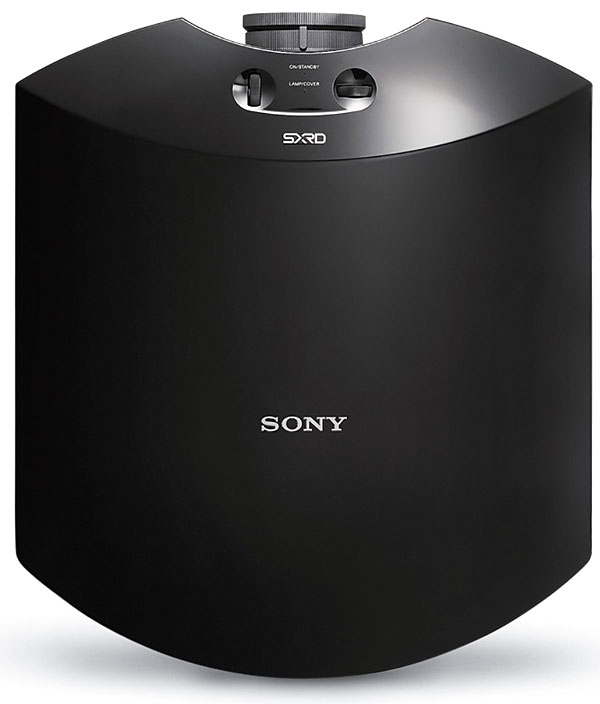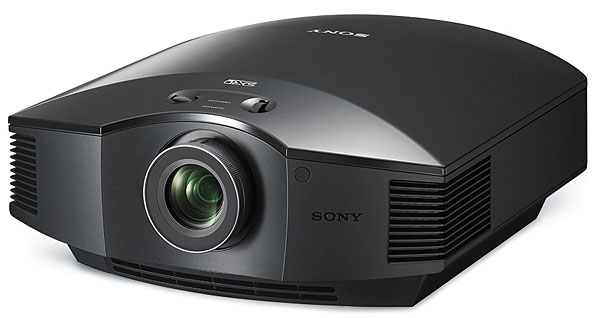Sony VPL-HW45ES 3D SXRD Projector Review Page 2
Performance
The Sony passed all of our standard video tests. The top luma-resolution burst was slightly pink (not unusual in SXRD or LCOS displays), and the highest chroma-resolution burst had a slight rolloff (also common in video displays—of all types). But we couldn’t run our standard definition deinterlacing tests because the projector doesn’t accept a 480i input via HDMI; legacy 480i sources (should you have any) must be first converted to 480p or higher resolution by an external device, such as an A/V receiver. 480i standard-definition broadcasts, if you could find any today, would be converted by your cable set-top box.
 After breaking in the lamp for 100 hours without watching the projector, I settled in for at least 20 hours of pre-calibration viewing. The Sony impressed me immediately, even before calibration. It was very quiet in its Low lamp mode, though not totally silent. I could barely hear a slight fan whine from a few feet away—with no audio playing. The High lamp mode was only slightly louder. Sony’s home theater projectors, including this one, remain among the quietest available.
After breaking in the lamp for 100 hours without watching the projector, I settled in for at least 20 hours of pre-calibration viewing. The Sony impressed me immediately, even before calibration. It was very quiet in its Low lamp mode, though not totally silent. I could barely hear a slight fan whine from a few feet away—with no audio playing. The High lamp mode was only slightly louder. Sony’s home theater projectors, including this one, remain among the quietest available.
Whether the source was Blu-ray, cable TV, or streaming (from the smart apps on a Samsung UBD-K8500 Ultra HD Blu-ray player—in 1080p, of course), the picture was consistently impressive (though it certainly separated the great sources from the mediocre ones!). Colors looked true, detail was crisp, and images were exceptionally bright, even in Low lamp mode.
Once I set up my color meters, however, it became clear that the uncalibrated picture in the D65 Color Temp. setting was actually a bit off, with excessive blue. Still, it hadn’t been enough to bother me. And post-calibration, it was nearly ideal (see the Test Bench).
After months of reviewing bright flat-screen TVs, I was definitely spoiled for brightness. So I wanted to push the Sony projector as bright as I dared while still using the Low lamp mode. For this, I set the contrast just short of its maximum (though still a couple of steps down from the Reference mode’s default). That left me with only two or three steps of headroom above the peak level of 235 where signal brightness is supposed to max out (but doesn’t always). On test patterns, this setting also produced a slight pink tinge in the brightest bars. But I left it there; these minor artifacts were never visible on the real program material I watched, either before or after calibration, nor did they affect the white balance calibration. I judged the added brightness to be more than a fair tradeoff. This setting also suggests that the projector can maintain good brightness even on a larger screen than mine, for users who go that route.
With these settings, on my Elite screen, the Sony put out just under 23 foot-lamberts (79 nits) in the Low lamp mode (which I used for all of my viewing) and just over 38 ft-L (132 nits!) with the lamp on High. While this is still much dimmer than what’s possible from a flat-screen set, the far bigger projected picture largely overcomes this disadvantage. (Interestingly, the peak brightness in these settings was roughly the same on my wider Stewart screen, likely because of its higher gain of 1.3, as opposed to 1.1 on the Elite.)

After squaring up the projector with the Elite screen, I found that the left side of the picture was a little sharper than the right, but this isn’t uncommon and was only clearly visible when standing very close to the screen. I’m not a product bean-counter, but I suspect that the optical path, including the lens, is the costliest component in any projector. At this price, you can’t expect to get a premier, state-of-the-art lens. (Just ask any camera buff how much the best lenses go for.) But from a viewing seat 12 feet from the 87-inch Elite screen (a frontal viewing angle of 33.6 degrees) or 13 feet (31.2 degrees), the picture’s resolution never disappointed me when the projector was fed with good source material. This was particularly true after I fine-tuned the Sony’s alignment with the screen and spent an hour or so with its Panel Alignment feature, eliminating all but the subtlest errors in color convergence.
The Sony’s post-calibration color also looked perfect (for BT.709), from fleshtones to green foliage. Both of my screens worked beautifully with the Sony, even the larger, 8-foot-wide Stewart. (From 13 feet, the latter produced a viewing angle of just over 34 degrees.)
Among the Blu-rays I use for testing color, resolution, and motion is a Samsung release (not commercially available) with a wide range of real-world material. Another manufacturer-produced test Blu-ray, by Pioneer from 2006, is equally useful. I’ve viewed both of them dozens or perhaps hundreds of times. The only comment-worthy limitation that these discs turned up was the Sony’s satisfactory but unexceptional black level and shadow detail. This only rarely distracted me, however, and I’m as paranoid about these qualities as any video nerd. On everything else, the projector worked beautifully. And while some viewers are sensitive to the motion smear that’s typical of some digital displays, this never bothered me on the Sony—even with its Motionflow off (always my preferred setting).
For most real-world material, I turned on the Sony’s Reality Creation, with its Resolution set to 10 (very low) and its Noise Filtering off, and I set Sharpness to 30. This worked ideally, without visible edge enhancement at the viewing position. But when I popped The Truman Show into my disc player, the images looked just a little edgy and over-enhanced in these settings. When I turned off Reality Creation and reduced Sharpness to 10, everything was put right.

These days, our thoughts don’t often drift to visions of sugarplums and 3D. But I did briefly audition the Sony’s 3D performance (though I didn’t carry out a separate 3D calibration). In the default Bright Cinema 3D Calibrated Preset, which sets the Lamp Control to High and maxes out the Contrast, the 3D picture was clearly dimmer than 2D in the 2D Reference mode’s Low lamp setting. This bothered me for a few minutes, but after adjusting to it, I hardly gave it another thought. Discussing 3D might well be closing the barn door after the horse has run off, but it’s still important to some enthusiasts. And the Sony produced perhaps the best 3D I’ve yet seen from a home projector. The brightness was more than adequate, the depth palpable, and the color good, and I saw no sign of ghosting in the limited time I spent with the projector in 3D.
Conclusions
On more than one occasion, when I merely intended to sample a few scenes from a specific movie, I found myself watching virtually the entire thing, from start to finish. The Truman Show, as I mentioned earlier, profited from a few adjustments to the user controls, after which it was a treat throughout. Saving Mr. Banks is a beautifully photographed film, a fact far more obvious on the Sony than I had ever noticed before. And because the gags in the original Despicable Me continue to hold up, they sometimes made it harder for me to look for something the projector was doing wrong. (And actually, it was doing nothing wrong!)
That staying power certainly suggests a strong recommendation for the Sony VPL-HW45ES. If your budget is small but not tiny, this projector demands a close look. If you can afford more but want to delay a few years for the 4K/HDR thing to trickle down to a sensible price level (but one that still won’t show up in Costco or Walmart), the VPL-HW45ES won’t disappoint you while you wait it out.
























































